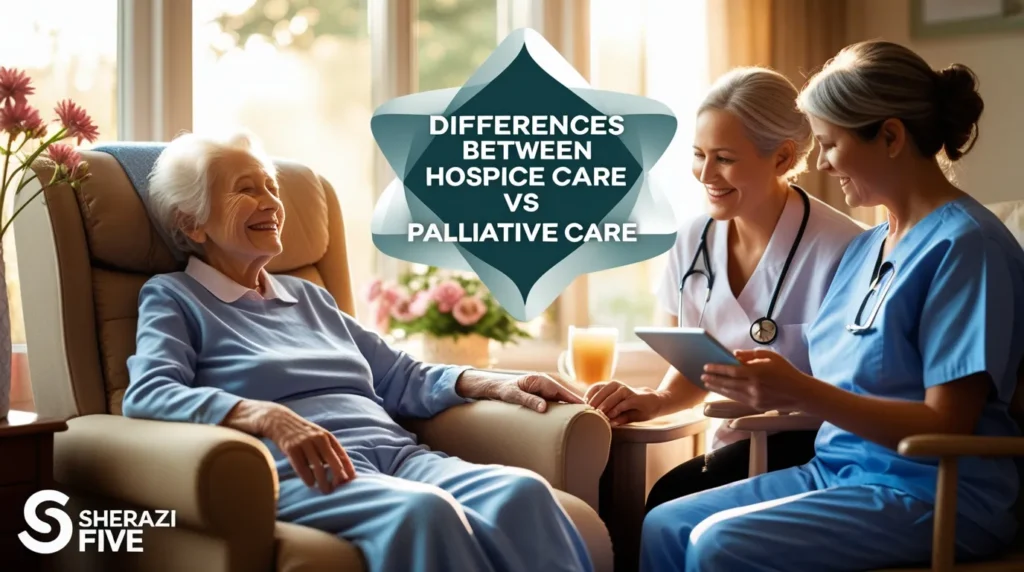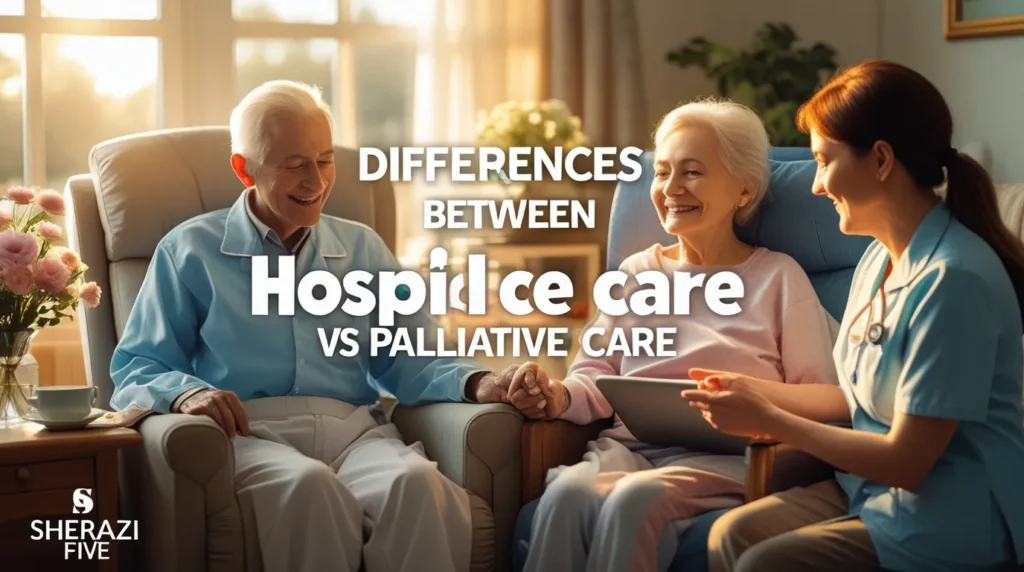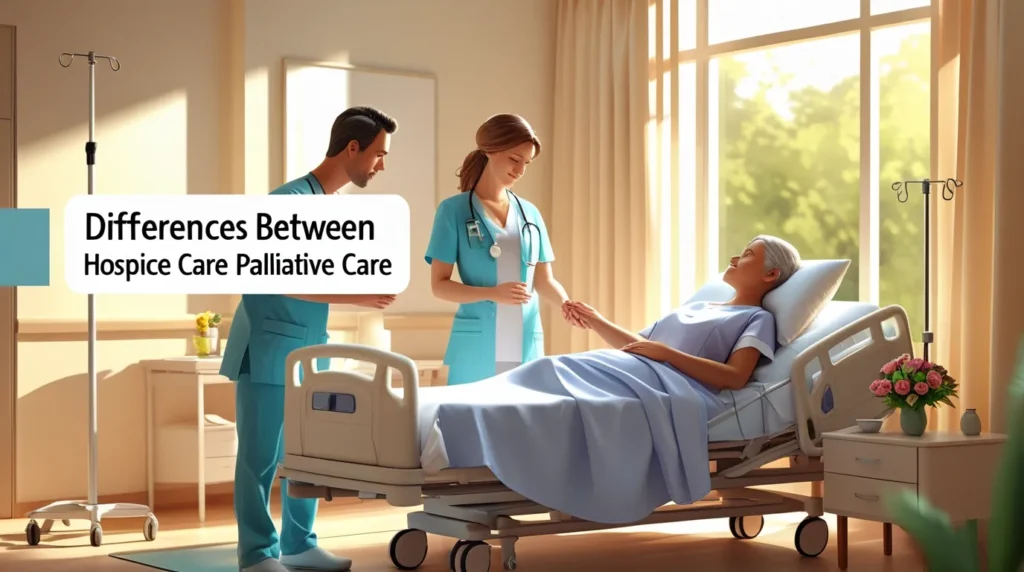Choosing the right care for a loved one facing a serious illness can feel overwhelming. Understanding the Differences Between Hospice Care vs Palliative Care helps families make thoughtful, compassionate choices. Both approaches focus on comfort and dignity, yet they serve patients at different stages of illness.
While end-of-life care is central to hospice, symptom management is often the focus in palliative care. Knowing how each service supports quality of life, addresses emotional needs, and guides family caregiver support is essential. This guide explains these programs in simple terms so you can confidently choose the care that best meets your loved one’s needs.
Understanding Hospice Care in the USA

Hospice care is designed for people with a terminal illness who are likely to live six months or less. The main goal is comfort and dignity during the final stage of life. In the USA, Medicare hospice benefit usually covers most of the costs, including medication, supplies, and 24/7 nurse access.
Unlike hospital care, hospice often takes place in the patient’s home or a hospice facility. A dedicated hospice team—including nurses, doctors, social workers, and chaplains—provides emotional, medical, and spiritual support. This care helps patients spend their remaining days with less pain and more peace.
What Is Palliative Care and Who Needs It
Palliative care supports people living with chronic illness or those undergoing treatments such as chemotherapy. It is not limited to end-of-life situations. The focus is on symptom management, such as pain, fatigue, and stress, while allowing patients to continue treatments like surgery, chemo, or dialysis.
Many patients start early palliative consultation soon after a serious diagnosis. This approach improves quality of life and reduces frequent emergency room visits. Palliative care can be provided in hospitals, clinics, or at home, often alongside standard medical treatments.
Key Differences Between Hospice Care vs Palliative Care

The most important differences between hospice care vs palliative care lie in timing, treatment goals, and eligibility. Hospice begins when a person stops curative treatments and focuses only on comfort at the end of life. Palliative care can start at any stage of a serious illness and works alongside active treatments.
Here’s a simple comparison:
| Aspect | Hospice Care | Palliative Care |
|---|---|---|
| Timing | For last 6 months of life | At any stage of serious illness |
| Treatment Allowed | Comfort-focused, no curative treatments | Can continue treatment like chemo |
| Main Goal | Peaceful, dignified end-of-life care | Symptom management and quality of life |
| Insurance Coverage | Covered under Medicare hospice benefit | Often covered by insurance or Medicaid |
| Setting | Home or hospice facility | Hospital, clinic, or home |
Eligibility Criteria for Hospice vs Palliative Care

In the USA, to receive hospice care, a doctor must certify that the patient has a life expectancy of six months or less. This is often used for advanced cancer, late-stage heart failure, or similar conditions. Patients usually stop aggressive treatments like chemo or radiation.
Palliative care has broader eligibility. It is for anyone with a chronic illness—for example, COPD, Alzheimer’s, or Parkinson’s—who needs better symptom management. You can receive it while still undergoing standard treatments and even during early stages of disease.
Cost and Insurance Coverage in the United States
Cost often shapes care choices. The Medicare hospice benefit covers almost everything in hospice: medications for pain and comfort, medical equipment such as hospital beds, and in-home visits by the hospice team. This coverage is available in all 50 states.
Palliative care coverage can vary. Many private insurers and Medicaid programs pay for palliative treatment options, but patients may still face copayments for medications or clinic visits. Talking to your doctor and insurance provider helps clarify what’s included in your plan.
Care Teams and Services Offered in Both Programs

A hospice team typically includes doctors, nurses, social workers, home health aides, chaplains, and volunteers. They provide home-based care, manage pain, offer emotional support, and guide families through advanced care planning. Medications and supplies are delivered to the home at no extra charge.
In palliative care, the symptom management team focuses on controlling pain, fatigue, and stress. Services may include regular consultations, counseling, and guidance for both patients and families. However, home visits or equipment might not be provided by every palliative program.
Transitioning from Palliative Care to Hospice Care

Many patients begin with palliative treatment options and later move to hospice as their illness progresses. This transition usually happens when curative treatments are no longer effective or desired, and the focus shifts entirely to end-of-life care.
For example, a patient with advanced lung cancer may use palliative care for months while undergoing treatment. When treatments stop working and the priority becomes comfort and dignity, the patient may enter hospice care for the final stage of life.
Common Myths and Misconceptions
A frequent myth is that enrolling in hospice means “giving up.” In truth, hospice is about providing compassionate end-of-life care and improving comfort. Many families find it helps patients live more peacefully and even longer due to better pain and stress control.
Another misconception is that palliative care is only for the dying. In reality, palliative services benefit anyone with a serious illness, even at early stages. Early symptom management often keeps patients out of the hospital and improves their overall quality of life.
Choosing the Right Program for You or Your Loved One
Choosing between hospice and palliative care depends on treatment goals, illness stage, and quality of life needs. If a patient is still pursuing active treatments like chemotherapy, palliative care is often the best choice. If the goal shifts to comfort at the end of life, hospice is the right fit.
It’s vital to involve your healthcare team in this decision. Doctors can help assess your situation, explain insurance and cost coverage, and guide you toward the program that matches your medical needs and personal wishes.
Emotional and Family Support in End-of-Life and Chronic Care

Both hospice and palliative care recognize that families need support too. Hospice often includes grief counseling, 24/7 nurse hotlines, and spiritual guidance for patients and caregivers. These services ease emotional burdens and offer comfort through difficult times.
Palliative care provides counseling and education for caregivers, helping them cope with stress and learn better ways to support their loved one. This shared approach improves overall quality of life for both patients and their families.
Hospice Care vs Palliative Care Timeline of Services
In many cases, palliative treatment options start at the time of diagnosis to control symptoms and reduce hospital visits. As the illness advances and treatment becomes less effective, families may shift to hospice care for full end-of-life care.
This timeline shows how both programs work together. Palliative care improves daily living during treatment, and hospice provides dignity and peace during the final months of life. Understanding this path can help families plan ahead with confidence.
FAQs
How is palliative different from hospice?
Palliative care manages symptoms at any stage of illness, while hospice focuses on end-of-life comfort when treatment stops.Is palliative care the last step before hospice?
Not always; palliative care can start anytime, and some patients may never move to hospice.Can you be on palliative care and not be dying?
Yes, palliative care helps anyone with serious illness, even if they aren’t terminal.What qualifies someone for palliative care?
A patient with a serious or chronic illness needing symptom management qualifies.What comes first, hospice or palliative?
Palliative care usually comes first; hospice is for end-of-life care.Why do doctors recommend palliative care?
To reduce pain, manage symptoms, and improve quality of life alongside treatment.What hospice won’t tell you?
Hospice may limit hospital visits and aggressive treatments, which some families find surprising.Who typically pays for palliative care?
Insurance, Medicare, or Medicaid usually cover palliative care, depending on the plan.Does palliative care give IV fluids?
Sometimes, if medically needed, but it depends on the facility and patient condition.Does palliative care include home visits?
Many programs offer home visits, but availability varies by provider.Will Medicare pay for palliative care?
Medicare often covers palliative care when prescribed alongside treatment.How long can you stay in palliative care in a hospital?
There’s no fixed limit; it continues as long as symptoms need management.What does 40 mean in hospice?
It usually refers to a specific billing or regulatory code; context is facility-specific.What are the top 5 hospice regrets?
Common regrets: wishing for better pain control, more time at home, improved communication, emotional support, and completing personal affairs.Does hospice cover 24-hour care at home?
Hospice provides 24/7 support via on-call nurses but not constant in-person care.Can you have palliative care at home?
Yes, many palliative programs provide home-based visits and support.Why is palliative care better than hospice?
It allows ongoing treatment while managing symptoms, unlike hospice which focuses solely on end-of-life.Does hospice pay for nursing homes?
Hospice may cover some nursing home services, but coverage varies by plan.What is the downside of hospice?
Limitations include no hospital admissions, no aggressive treatments, and reliance on family caregiving.What shuts down first in hospice?
Usually, body systems like digestion and circulation slow down first, followed by consciousness.What is the average life expectancy of most hospice patients usually?
Most hospice patients live about 1–6 months, depending on their illness.Can someone be on hospice for years?
Rarely; hospice is intended for patients with under six months to live, though extensions are possible.Is hospice better at home or a facility?
Home hospice is preferred for comfort, while facilities provide more medical support.Which of the following individuals would a doctor most likely recommend for hospice care?
Someone with a terminal illness and less than six months to live.What disease do most hospice patients have?
Most hospice patients have cancer, heart failure, or dementia.How long can someone live on hospice without food and water?
Typically days to a couple of weeks; it varies with health and hydration.What are the last senses to go before death?
Hearing is often the last sense to fade, even when other senses decline.Why Is My Ear Clogged After Swimming? Causes, Relief & Prevention
✅ Final Thoughts
Understanding the differences between hospice care vs palliative care empowers families to make thoughtful decisions. Both aim to improve quality of life—one during treatment, the other at life’s end. By asking your doctor the right questions and exploring options early, you can ensure compassionate, personalized care for you or your loved one.




